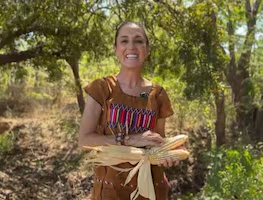Más Información

Magistrada Mónica Soto propone sustituir al Comité de Evaluación del PJ; plantea someter a insaculación a aspirantes elegibles

Magistrado Reyes Rodríguez propone validar registros de aspirantes con promedio inferior a 8; excluirlos es “estigmatizante”, señala

¿Eres madre trabajadora? Puedes acceder a las guarderías del IMSS; descubre los requisitos y cómo hacerlo

El primer megapuente de 2025 se acerca; ¿cuándo inicia y qué estudiantes tendrán descanso de 4 días?

Sheinbaum reitera protección a maíz mexicano; iniciativa enviada al Congreso rechaza siembra de trangénico
The recent discovery of bones of a mammoth, a horse and an armadillo ancestor of around 13,000 years old show the paleontological richness of the south of Jalisco , in Western Mexico, an agricultural area where vestiges are often at the hand of inhabitants and are barely preserved.
Last July, while he was walking in San José de la Tinaja , in the municipality of Zapoltitic , in southern Jalisco, one of the employees of the community museum Antonio Vargas Moreno , a paleontology fan, found part of what would later be identified as a piece of the skull of a mammoth .
The employee reported it to the experts of the Paleontology Museum and the National Institute of Anthropology and History (INAH).
When they arrived, they noticed that there were also remains of horse ancestors and a glyptodont , a mammal similar to the armadillo , said the archeologist Eduardo Ladrón de Guevara .
The remains belong to the great fauna that lived in the region from 13,000 to 30,000 years ago and were revealed when heavy rain eroded the place and exposed them.
“During the first visit, we could only see the cranial cavity of the mammoth, and when we came back to perform the paleontological rescue, more started to emerge. The hill is a field of scattered bones and while we walked in the surface, we located different bones of a glyptodont , horse , and more mammoth bones ,” explained the researcher of the INAH in Jalisco.
During the days in which they worked on the land, the experts noticed that this kind of findings are common in the area since the region was previously full of lakes and lagoons that attracted animals and whose bones are now scattered under the earth.
“Jalisco is rich in remains and it is usual for people to keep the bones , which is not exactly a crime,” but is not the best for their preservation , said the specialist.
Ladrón de Guevara added that, according to Mexican laws, any person can guard archeological heritage in his house, garden or any space of his or her property, with prior authorization from the INAH.
Nevertheless, this option “is not desirable ” since the remains tend to deteriorate or can get harmed without adequate preservation strategies.
“It is a bone that was kept for thousands of years under stable conditions that allowed its conservation and when you extract it and put it in another environment its deterioration accelerates. Besides, if you have it in your house it is quite excluding because the rest of the community can’t have access to this heritage,” he said.
Once the remains were rescued, they were taken to the Paleontology Museum , in Guadalajara , the capital of Jalisco.
There, they are being subjected to c onsolidation, restoration, and preservation processes so that they can be studied and exhibited to the public, asserted to EFE Ricardo Alonso , in charge of the Research area of the museum.
“We do a mechanical cleaning, and then a consolidation to toughen the remains. When materials can be manipulated, a reconstruction is made, piece by piece, of each bone, until the material is in conditions of being cataloged, exhibited and studied ,” he detailed.
The process takes up to six months , but considering the fragility and fragmentation of the material, in addition to the limitations of the staff in charge of this labor, it could extend to up to a year, said Alonso.
Recovering and maintaining these pieces is a way to add to l ocal history and geography knowledge.
“It allows us to rebuild part of the history of the state and the country, and in this history, humans were not always present. It allows us to know the landscape , the way in which the territory was made, how it gave place to what we know now and in which moment we, as human beings, started to have a role in this landscape,” concluded Ladrón de Guevara.
mp







